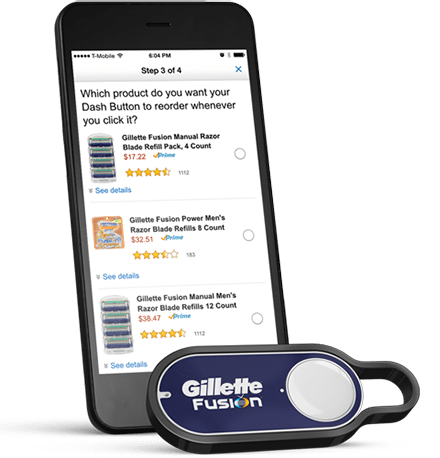
Amazon.com Dash Button
One click and more will be on your doorstep in 2 days!
I have to admit when I first saw the “Dash Button” on Amazon.com I got pretty excited. I haven’t seen a potentially transformative application of technology for advertising like this in quite some time. It just makes sense. The technology has come along far enough where it is now cost effective enough to produce a WiFi connected device that doesn’t need to be plugged in and is essentially a throw-away. We can thank the IoT movement for these devices, the miniaturization of these technologies to the point that they can be powered by a watch battery for a year and cost a couple bucks to make. I remember when I got that HitClips of Britney Spears back in the late 90’s, technology had become a McDonald’s happy meal throw-away. Fast forward 16 years and we are handing out wifi devices like pens at a trade show. I know that analogy might not be completely fair as I am sure Amazon is relying on their oh so successful razor and razor blades model of giving you the keys to their ecosystem for free and making all their money on the back end when you fill it up with gas (mixed a few metaphors there…). So what is the Dash Button and the underlying Dash Replenishment Service?
Dash Button:
The Dash Button is the consumers main connection to the Dash Replenishment Service. It’s not entirely clear if these will be available for any Amazon.com product or just advertising partners (most likely the later). One click of the button and the associated product will be ordered with you Prime 2-day shipping. One click, on your door 2 days later! Pretty powerful concept if you ask me.
The Dash Replenishment Service:
Amazon has gone one step further and made this automatic-ordering magic available to anyone who want their device to have a seemingly bottomless supply of consumables. No button necessary, developers can trigger a refill from whatever sensor is relevant to their customers. Printers, coffee makers, water filters and washing machines are some of the examples they give to start.
I can see this expanding to any area where you somewhat regularly order supplies, even new devices popping up that help you monitor supply levels to take advantage of this service. WiFi coasters that monitor the weight of the container you put on top and reorder if the weight is getting low. This could start a revolution in product packaging where the package is no longer a consumable, but the place-holder on your shelf that actively monitors your supply levels. You then have the replacement supply shipped in a more eco and shipping friendly package. A new wave of brand loyalty in a world where it has become easier than ever to switch to the lowest bidder.
If an open API were made available, the data gathered from this system (assuming it gets to a reasonable scale) would be invaluable to manufacturers and retailers; how often, how much, seasonality, etc. Even consumers could benefit from this data, how much coffee do you really use? Is it getting stale? Web services could analyze your habits and suggest better buying habits, would you save money by buying your dog food in bulk?
I look forward to seeing how this plays out.
How would you use this in your life? Tweet me @willcoffin #amazondash
